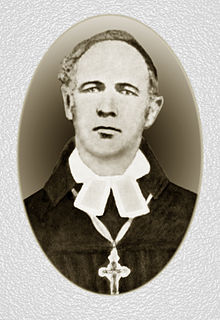Martin Koerber
Martin Koerber (* July 5 jul. / 17th July 1817 greg. In Võnnu , Livonia , † April 5 . Jul / 17th April 1893 . Greg in Kuressaare , island Saaremaa ) was a Baltic German pastor , composer, poet and choirmaster in the Baltic States .
Life
Martin Georg Emil Körber was born as the son of pastor Eduard Körber (1770–1850) in the pastorate of Võnnu ( Wendau ) in the Tartu district. His older brother was the Baltic German writer Carl Körber (1802-1883).
Körber attended high school in Tartu ( Dorpat ). From 1837 to 1842 he studied Protestant theology at the University of Tartu , which was then called the Imperial University of Dorpat .
Körber worked from 1842 to 1845 as a school teacher in Kuressaare ( Arensburg ) and from 1846 as a pastor in Anseküla ( Anseküll ) on the island of Saaremaa ( Ösel ). In Anseküla he founded an Estonian choir, with which he also performed secular songs.
In July 1862, Körber organized a choir performance with the local Estonian population in Kuressaare Castle. On May 21, 1863 he organized a large secular song festival with 60 singers and 500 listeners on the Sõrve ( Sworbe ) peninsula . It was one of the first singing festivals in what is now Estonia.
In 1873 Körber retired. In Kuressaare he settled as a homeland researcher. He died there in 1893. He is buried in the village of Kudjape in the rural community of Kaarma .
plant
The estophile Körber had a great influence on the development of an Estonian-speaking singing tradition. He composed numerous works for choral singing. His song books with self-written works contain over 1,000 sacred and secular songs in German and Estonian . The best-known pieces that are still very popular in Estonia today include Vaikne kena kohakene , Mu isamaa armas , Ma olen väike karjane , Kus on mu kallis isamaa? and Kiigu, liigu, laevukene . The German, mainly sentimental songs of the time served as models for him. The prints of Körber's songs were widespread among the Estonian population.
In 1846 Körber published the catechism Õnsa Lutterusse Katekismusse ramat, ärraselletud . The work was in use for a long time. It had 57 editions and was printed over 300,000 times. In addition, Körber wrote stories, prayer books, memoirs, research on the mythological legendary figure Suur Tõll and, as a member of the Verein zur Kunde Oesels, local and historical treatises. The 900-page Opus Oesel once and now appeared in print for the first time in 1887 and covers the history of Saaremaa extensively (three volumes, 1887–1915). Körber's building blocks for a story of Oesel had already been published in 1885 .
Martin Körber's song collections
- Sörvema löuke ehk 30 mönnusat laulo (1862)
- Sarema laulik, üks mönnus luggemisse ramat nore ja wanna rahvale (1864)
- Laulud Sõrvemaalt, mitme healega (Volume I 1864, Volume II 1867)
- Sarema Kuldnok, ilmaliku laulude koggu nore ja wanna rahwa melejahhutuseks (1879)
literature
- Aarne Vinkel: Martin Körber. Elutee- yes töö. Tallinn 1994
- Carola L. Gottzmann / Petra Hörner: Lexicon of the German-language literature of the Baltic States and St. Petersburg . 3 volumes; Verlag Walter de Gruyter, Berlin 2007. ISBN 978-3-11-019338-1 . Volume 2, p. 707.
Web links
- Baltic Historical Commission (ed.): Entry on Martin Körber. In: BBLD - Baltic Biographical Lexicon digital
- CV, works, pictures (Estonian)
- Short biography (Estonian)
Individual evidence
- ↑ Archived copy ( Memento of the original from July 30, 2001 in the Internet Archive ) Info: The archive link was inserted automatically and has not yet been checked. Please check the original and archive link according to the instructions and then remove this notice.
- ↑ Eesti elulood. Tallinn: Eesti entsüklopeediakirjastus 2000 (= Eesti Entsüklopeedia 14) ISBN 9985-70-064-3 , pp. 2211f.
- ↑ http://register.muinas.ee/?menuID=monument&action=view&id=4102
| personal data | |
|---|---|
| SURNAME | Koerber, Martin |
| BRIEF DESCRIPTION | Baltic German pastor, composer and choir director |
| DATE OF BIRTH | July 17, 1817 |
| PLACE OF BIRTH | Võnnu , Livonia |
| DATE OF DEATH | April 17, 1893 |
| Place of death | Kuressaare , Saaremaa Island |
